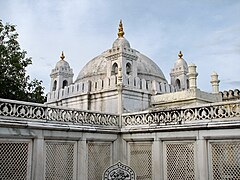Khuldabad
The Bhadra Maruti Temple and Dargah of Zar Zari Zar Baksh, Shaikh Burhan ud-din Gharib Chisti and Shaikh Zain-ud-din Shirazi, along with the tomb of the Mughal emperor Aurangzeb and his trusted General Asif Jah I, the first Nizam of Hyderabad, are located in this town.
People come from Aurangabad and nearby places by walk for offering puja on Hanuman Jayanti and on Saturdays in Marathi calendar month "Shravan".
A significant portion of the Muslim elite that migrated consisted of Sufis, many of whom settled in the neighbouring town of Rauza (the older name of Khuldabad).
Aurangzeb himself chose to be buried here, following which the town acquired its modern name of Khuldabad from the ruler's post-humous title 'khuld-makan'.
It has seven gates viz., Nagarkhana, Pangra, Langda, Mangalpeth, Kumbi Ali, Hamdadi and a wicket called Azam Shahi.
The gateway in the direction of Aurangabad is approached by a paved ascent which continue inside the town for about 200 to 300 feet.
A steep paved ascent some 30 yards in length leads from the road side to the entrance of the building.
Facing it is a long low building similar to the one in the outer quadrangle, and in the north end is a small room containing the pall and decorations of the tomb.
Unlike the other great Mughal rulers, Aurangzeb's tomb is not marked with a large mausoleum instead he was interred in an open air grave in accordance with his Islamic principles.
It was erected by the Nizam at the request of Lord Curzon, then Viceroy of India (who was shocked by the simplicity of the tomb) in the year 1911.
On ceremonial occasions, Aurangzeb's grave is draped with richly embroidered cloth but ordinarily it is covered by a white sheet.
[citation needed] Midway between these tombs and that of Aurangzeb, is the mausoleum of Sayyed Zain ud din, a Muhammedan saint highly revered by the Muslims.
The doors of the shrine are inlaid with silver plates, and the step below is embellished with a number of curiously cut and polished stones.
The grave inside is covered with a richly embroidered pall, and has the usual string of ostrich eggs suspended over it.
The relics of the parahan and the taj given to Burhan-ud-din on succeeding to the Caliphate we carefully preserved in a wooden box placed in one of the apartments of Zain-ud, din's dargah.
He migrated to Daulatabad in the wake of Muhammad Tughluq's transfer of capital from Delhi and later, made Khuldabad his abode, dying there in 744 H. (1344 A.
To the right of Burhan-ud-din's tomb are the resting places of Nizam-ul-Mulk Asaf Jah I, the founder of the Hyderabad dynasty, his second son Nasir Jang.
To the west of this group of tombs is the Makbara of Bani Begum, the consort of one of Aurangzeb's son, with the Lall Bagh of Khan Jahan close by.
An elegant kiosk at each corner angle stands on eight pillars, and is surmountedby an Indo-Saracenic dome, fluted externally.
The ground inside is laid out in the usual form of a garden, and contains cisterns and fountains, no longer in working order.
A pretty summer house in the centre of each wall in this wound enclosure, has sixteen slender but elegant pillars, supporting a domed roof in the curious form belonging to the Bengal style.
The Lall Bagh was built by Aurangzeb's foster-brother Khan Jahan, who was on two occasions Viceroy of the Dakhan, and died about the end of the 17th century.
"The water supply is obtained from the Roza tank, and first fills a cistern on the top of an adjoining house, from which it runs down a sloping pavement, into the garden."
A red porphyritic trap, and a cement of the same colour, have been used in the buildings, and hence the name Lall Bagh which has been given to the garden.
Though the smaller is also of the same general appearance, it does not have the facade decorated with recesses and cusped arches in stucoo plaster.
To the north of the town is the tomb of Nizam Shah Bhairi which was converted into a trvelles' bungalow by the officers of the contingent stationed at Aurangabad during British days.
The mausoleum at the base of the hill close by was erected for himself by Khoja Firoz while engaged in building the tomb of Nizam Shah Bhairi.
His dargah has the horse-shoe shaped dome of the Pathans, with piers on the faces supporting pointed arches.
The mausoleums of Abdal Halim and Kak Shahr, situated to the south of Khuldabad have some old pillars probably taken from the ruins of abandoned Hindu temples.











